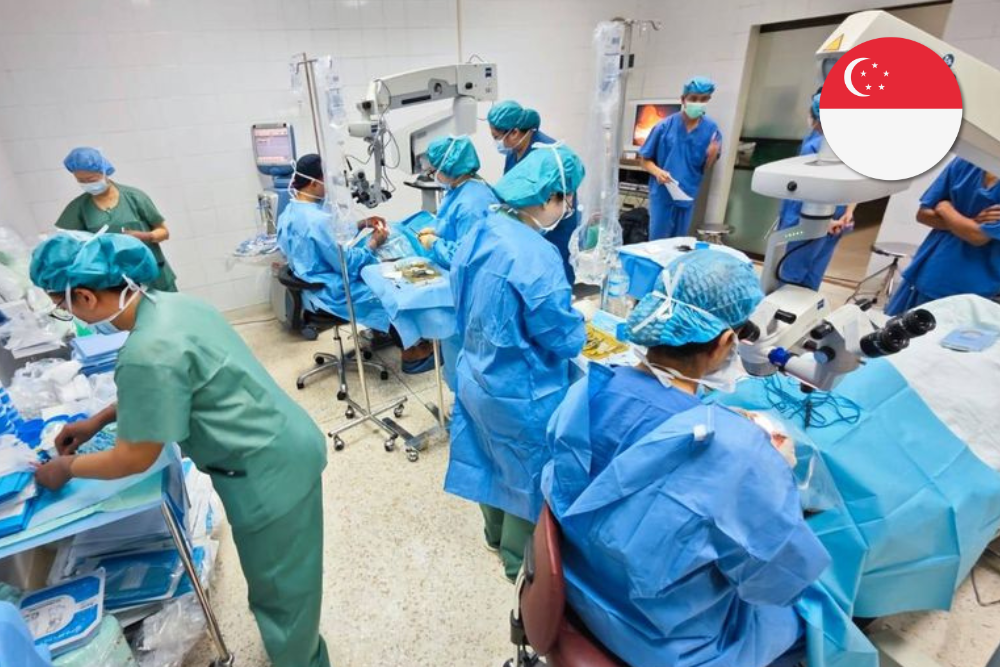Doctors and nurses from the Singapore National Eye Centre (SNEC) recently travelled to Laos on a life-changing mission: to bring essential eye care to Laotian patients in need.
Over five intensive days, the team screened more than 500 patients and performed free cataract surgeries for approximately 150 people, transforming lives in communities with limited access to medical resources.
Despite challenges like language barriers and outdated equipment, the team succeeded in restoring sight to patients who had waited years for treatment.
“It was hard to understand their symptoms,” Yep recalls to Channel News Asia. “We were afraid that we might miss crucial information from the patients regarding their medical history.”
Breaking Through Language Barriers to Deliver Care
In the crowded screening room of Vientiane’s National Ophthalmology Centre, optometrist Yep Zhen Ting strained to bridge the language divide between her and her patients. Most patients spoke only Lao, a language the Singaporean team barely understood.
Outside the doors, the line of patients grew longer by the hour. Many of them were farmers who earned less than $2 a day, people for whom cataract surgery – and the hope of restored vision – had remained beyond reach.
Inside, the SNEC team adapted quickly.
Senior Nurse Goh Hui Jin shared that the team enlisted translators from a local international school for support and arranged English lessons for the Vientiane staff and doctors.
To speed up exams, the team also “learned key Lao vocabulary to improve communication during eye examinations.” Basic phrases like asking patients to open and close their eyes, look in different directions, and indicate any pain helped bridge communication gaps and improve patient flow.
Watch now: Myopia Management — Are Glasses Enough?
Structural Challenges in Laotian Eye Care
The mission was about more than just immediate care—it also addressed longer-term needs in Laos’ eye care infrastructure.
“They have an estimated population of 7 million people with only 35 trained ophthalmologists, mostly sited in the capital city. In comparison, Singapore has about 400 ophthalmologists,” says Dr Anna Tan, SNEC’s Director of Global Ophthalmology.
Dr Tan highlights facility challenges, noting that many essential devices at Vientiane’s main hospital were in disrepair. This urgent need prompted SNEC to prioritise Laos in its Global Eye Health programme. The programme aims to strengthen eye care development across Southeast Asia.
Advancements in Local Ophthalmology
One of the mission’s objectives was to empower Laotian eye care providers to deliver consistent, high-quality care.
Among the Laotian team trained by Singapore doctors is Dr Keovongkoth Nouanphanthakoun, an ophthalmologist in Vientiane. Earlier this year, he trained at SNEC and gained insights into Singapore’s structured approach to eye care. His training covered essential patient care techniques and systematic procedures, which he can then apply in his local practice.
Looking ahead, SNEC plans to sign a memorandum of understanding with the National Ophthalmology Centre in Vientiane. This collaboration focuses on building skills within Laos’ eye care system by providing specialised training at hospitals, especially in underserved districts. It also aims to equip local trainers with essential expertise.
Dr Tan also shared that they “plan to improve the skills of not only the medical eye health professionals, but also the support staff such as biomedical engineers and administrators,” to expand knowledge and support across all areas involved in eye care.
SNEC as Southeast Asia’s First WHO Collaborating Centre for Eye Care
Earlier this year, SNEC’s Global Ophthalmology unit was designated as the World Health Organization (WHO) Collaborating Centre for the Prevention of Blindness and Vision Impairment, the first in Southeast Asia. This recognition emphasises SNEC’s ongoing commitment to improving eye care standards and accessibility across the region.
As part of the collaboration, SNEC is responsible for supporting eye care workforce development in Southeast Asia, sharing evidence-based practices, and building research capacity for blinding diseases. The designation also allows SNEC to bring a more comprehensive approach to eye care in Laos, reinforcing training, service, and research initiatives.
Professor Aung Tin, CEO of SNEC, expressed pride in this role, saying, “SNEC is honoured to be designated as the first WHO Collaborating Centre for the Prevention of Blindness and Vision Impairment in the region.”
He added that SNEC looks forward to collaborating with WHO counterparts to “positively impact the lives of many in the region who are in need of eye care.”
The Impact on Laotian Patients
The project continues to expand, and Singapore and Laos are partnering closely to make eye care accessible for underserved communities. As a result, patients who regained their sight experience renewed hope and a greatly improved quality of life. Ultimately, the impact will resonate far beyond the operating room.
For many Laotian patients, the SNEC team’s visit truly meant a life-changing opportunity. Dr Keovongkoth described the profound effect on patients who had travelled long distances for treatment.
“They were very happy to be able to see clearly again.”, Dr. Keovongkoth shared.
As SNEC continues to work with Laotian healthcare providers, the aim is not just to restore vision, but to build a sustainable future for eye care in communities that need it most.
Cover image courtesy of Singapore National Eye Centre via Facebook
Learn more about eye care:

